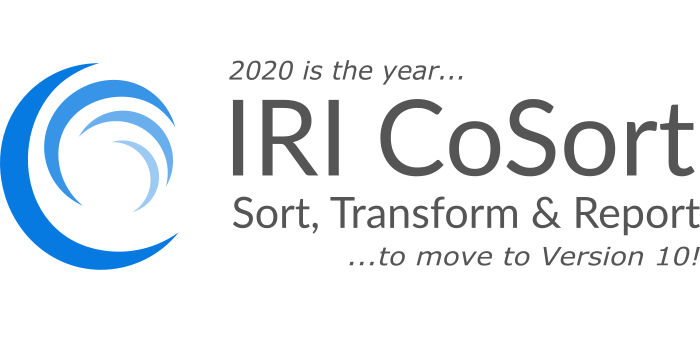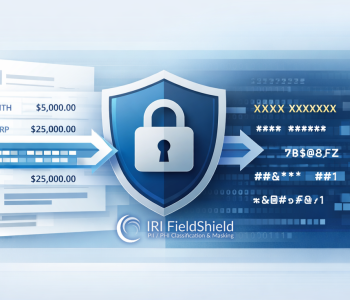
The Upgrade Path to CoSort v10
Forty years after the first release of IRI CoSort for CP/M, CoSort v10 for Unix, Linux, and Windows platforms was released in the middle of 2018. With official IRI support for CoSort v9.5 ending on 12/31/2020, this year is the time to move up to CoSort v10. Version 10 will be supported at least until the end of 2025.
This article summarizes the finer points, and answers common questions asked, about the upgrade. If you have any questions, use the comment form below or email cosort@iri.com.
What’s New in CoSort v10?
See the original release announcement here, product overview booklet here, and release notes here. In a nutshell, the new version is faster, supports more static and streaming sources, and improves foreign character and database data support. Its core SortCL program also powers CoSort, and more, jobs in the IRI Voracity platform (see “Go Beyond Sorting” below, and these Capabilities).
Both CoSort and Voracity licensees share the same Eclipse front-end job design and management IDE called IRI Workbench. Workbench supports the graphical creation and modification of SortCL scripts for use in: IRI CoSort (sort, transform, report), IRI NextForm (data and DB migration), IRI FieldShield (data masking), and IRI RowGen (test data synthesis).
Installation & Licensing
Follow the Unix/Linux or Windows CoSort instructions in the installation guide here, review the best practices guide here, and request the confidential v10 product manual here. Request a v10 installation archive from your IRI representative that matches your O/S and chipset. You will need a different RegForm.txt file and license key.
Do not remove or change the location of your older/current CoSort release. Just install v10 to a new CoSort directory structure (usually cosort100). Run First Time Setup as usual and request the new license key by email. Indicate a fixed duration if that host will only be used for testing.
Regression Testing
Once you have v10 license keys (which are different from your older release), you will be able to test jobs in both versions by toggling between $COSORT_HOME folders.
If your job scripts run without error in the new version, compare its output to the old version’s. If you get an error message or difference in output, report all details to support@iri.com.
Go Beyond Sorting
If all you do with CoSort is sort files, and maybe occasionally filter, aggregate or reformat them, you’re still only scratching the surface of what you could do at no extra cost. In the same or different SortCL jobs, you can also join, re-map, cleanse, PII-mask, report on, and wrangle data in DBs and files. Beyond transformation, you can use SortCL for intelligent test data generation.
Learn what you can get done — and combine — in one SortCL script and I/O pass. You will question the need for other ETL, data quality, data replication, data security, data wrangling, and test data tools. This will be more obvious once you get, update, and use IRI Workbench.
Frequently Asked Questions
Q. Is CoSort v10 backwards compatible with v9? Will my jobs made in a prior release still run?
A. Almost always. The more recent your version is (e.g., 9.5.3 vs. 9.1.2 vs. 8.2.1, etc.) is, the more likely no changes to your SortCL scripts would be needed. As a matter of policy and practicality, IRI has always endeavored to maintain backward compatibility with prior job syntax and output results.
However as features are introduced, sometimes syntax rules tighten to accommodate those features and avoid ambiguities. Changes to scripts or tuning settings may be needed to maintain consistent results. More complex scripts are more susceptible.
The best and only way to know for sure is to test your current scripts and output results using both your current and newer CoSort v10 SortCL executable, as you would any other new product release. See the advice above on how that’s done.
Q. How do I calculate the cost of the upgrade?
A. We’ll do that for you, but generally, for sites whose maintenance is current at the 20% license fee rate, there is no charge. There is a 10% surcharge on current license fees for those paying lower maintenance rates, and 50% for those whose maintenance lapsed.
Q. Is our maintenance renewal date affected when we upgrade?
A. No, that anniversary remains unchanged. You may find it more convenient to wait and combine the upgrade with your renewal transaction.
Q. Are there additional features in 10 coming out? Do I have time to wait?
A. Yes. IRI is now also working on a point update that adds: direct support for .XLS and .XLSX sources and targets, combined case and encryption functions, encryption of UID/PW information in DB table /IN and /OUTFILE statements, and graphical data quality rule specifications for SortCL job reuse in IRI Workbench. If you want these, wait until Q3 to upgrade to v10.
Q. What happens if we don’t upgrade? Will you still support us?
A. Yes, if you pay for it, and as you recognize that our ability will be curtailed in some material ways. We are only able to support older releases “unofficially” through institutional memory, and cannot provide any patches or new shipments of older versions. Any bugs in an older release would have to be addressed with an upgrade.
Q. Do I need IRI Workbench? Is there a cost to use it?
A. No, and no. But, you don’t want to ignore it, and once you start using IRI Workbench, you won’t want to stop. In that free Eclipse IDE — where you can automatically create any SortCL-compatible jobs for any need — you can also import any existing jobs and more easily edit, share, schedule, and execute them on local or remote systems. Check out the script design and deployment aids here.
Q. Why/when would I license Voracity — which includes CoSort — instead of just CoSort?
A. A version upgrade is a good time to consider this question since you may be in a position to save money and/or get more capability at the same time — all without needing to make any changes to your CoSort SortCL jobs.
It’s just a question of whether you want IRI to directly support you doing more via IRI Workbench than what you’re doing now in SortCL. Consider Voracity for graphical ETL or for running many SortCL jobs interchangeably in Hadoop, etc.
Also, the more hostnames you now or could have running CoSort, the more Voracity makes economic sense. Both the subscription and perpetual use pricing tiers include a generous number of hostnames for the same price, and do away with model, RAM, and core accounting.
See the comparative feature matrix here, and request a price quote to compare the cost of both options.











